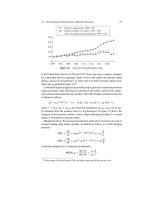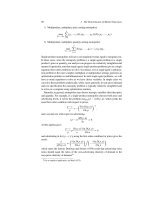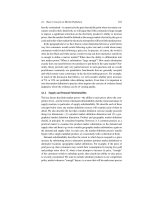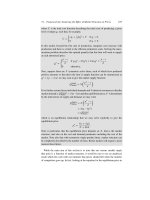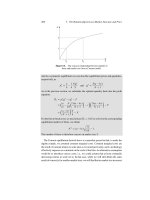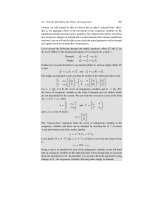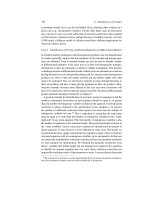the external environment opportunities, threats, industry competition, and competitor analysis
Bạn đang xem bản rút gọn của tài liệu. Xem và tải ngay bản đầy đủ của tài liệu tại đây (468.44 KB, 30 trang )
Ch2-1
Chapter 2
The External Environment:
Opportunities, Threats, Industry
Competition, and Competitor
Analysis
Michael A. Hitt
R. Duane Ireland
Robert E. Hoskisson
©2000 South-Western College Publishing
Ch2-2
The Strategic
The Strategic
Management
Management
Process
Process
The Strategic
The Strategic
Management
Management
Process
Process
Chapter 3
Internal
Environment
Chapter 2
External
Environment
Strategic Intent
Strategic Mission
Strategy Formulation Strategy Implementation
Chapter 4
Business-Level
Strategy
Chapter 5
Competitive
Dynamics
Chapter 6
Corporate-Level
Strategy
Chapter 8
International
Strategy
Chapter 9
Cooperative
Strategies
Chapter 7
Acquisitions &
Restructuring
Chapter 10
Corporate
Governance
Chapter 11
Structure
& Control
Chapter 12
Strategic
Leadership
Chapter 13
Entrepreneurship
& Innovation
Strategic
Inputs
Feedback
Strategic
Outcomes
Strategic
Strategic
Actions
Actions
Strategic
Competitiveness
Above Average
Returns
Ch2-3
Political/
Legal
Economic
Technological
Global
Demographic
Sociocultural
Competitive
Competitive
Environment
Environment
Industry
Environment
Components of the General Environment
Ch2-4
Components of the General Environment
Ch2-5
External Environmental Analysis
The external environmental analysis process should be
The external environmental analysis process should be
conducted on a continuous basis. This process includes
conducted on a continuous basis. This process includes
four activities:
four activities:
Scanning
Scanning
Monitoring
Monitoring
Forecasting
Forecasting
Assessing
Assessing
Identifying early signals of environmental
Identifying early signals of environmental
changes and trends
changes and trends
Detecting meaning through ongoing observations
Detecting meaning through ongoing observations
of environmental changes and trends
of environmental changes and trends
Developing projections of anticipated outcomes
Developing projections of anticipated outcomes
based on monitored changes and trends
based on monitored changes and trends
Determining the timing and importance of
Determining the timing and importance of
environmental changes and trends for firms'
environmental changes and trends for firms'
strategies and their management
strategies and their management
Ch2-6
Top 10 U.S. States Moving
Top 10 U.S. States Moving
Toward Digital Economy
Toward Digital Economy
States in the top 10 of
those that are trying to
transform themselves to
the realities and needs of
a digital economy may
experience an influx of
high-tech companies and
skilled workers as well as
increases in tax revenues
External Environmental Analysis
Ch2-7
Threat of
New
Entrants
Threat of
New
Entrants
Porter’s Five Forces
Model of Competition
Ch2-8
Threat of New Entrants
Barriers to
Entry
Expected Retaliation
Expected Retaliation
Government Policy
Government Policy
Economies of Scale
Economies of Scale
Product Differentiation
Product Differentiation
Capital Requirements
Capital Requirements
Switching Costs
Switching Costs
Access to Distribution Channels
Access to Distribution Channels
Cost Disadvantages Independent
Cost Disadvantages Independent
of Scale
of Scale
Ch2-9
Bargaining
Power of
Suppliers
Threat of
New
Entrants
Threat of
New
Entrants
Porter’s Five Forces
Model of Competition
Ch2-10
Bargaining Power of Suppliers
Suppliers exert power
in the industry by:
* Threatening to raise
prices or to reduce quality
Powerful suppliers
can squeeze industry
profitability if firms
are unable to recover
cost increases
Suppliers are likely to be powerful if:
Suppliers are likely to be powerful if:
Supplier industry is dominated by a
Supplier industry is dominated by a
few firms
few firms
Suppliers’ products have few substitutes
Suppliers’ products have few substitutes
Buyer is not an important customer to
Buyer is not an important customer to
supplier
supplier
Suppliers’ product is an important
Suppliers’ product is an important
input to buyers’ product
input to buyers’ product
Suppliers’ products are differentiated
Suppliers’ products are differentiated
Suppliers’ products have high
Suppliers’ products have high
switching costs
switching costs
Supplier poses credible threat of
Supplier poses credible threat of
forward integration
forward integration
Ch2-11
Bargaining
Power of
Buyers
Threat of
New
Entrants
Threat of
New
Entrants
Bargaining
Power of
Suppliers
Porter’s Five Forces
Model of Competition
Ch2-12
Bargaining Power of Buyers
Buyers compete
with the supplying
industry by:
* Bargaining down prices
* Forcing higher quality
* Playing firms off of
each other
Buyer groups are likely to be powerful if:
Buyer groups are likely to be powerful if:
Buyers are concentrated or purchases
Buyers are concentrated or purchases
are large relative to seller’s sales
are large relative to seller’s sales
Purchase accounts for a significant
Purchase accounts for a significant
fraction of supplier’s sales
fraction of supplier’s sales
Products are undifferentiated
Products are undifferentiated
Buyers face few switching costs
Buyers face few switching costs
Buyers’ industry earns low profits
Buyers’ industry earns low profits
Buyer presents a credible threat of
Buyer presents a credible threat of
backward integration
backward integration
Product unimportant to quality
Product unimportant to quality
Buyer has full information
Buyer has full information
Ch2-13
Threat of
Substitute
Products
Threat of
New
Entrants
Threat of
New
Entrants
Bargaining
Power of
Buyers
Bargaining
Power of
Suppliers
Porter’s Five Forces
Model of Competition
Ch2-14
Threat of Substitute Products
Products
with similar
function
limit the
prices firms
can charge
Keys to evaluate substitute products:
Keys to evaluate substitute products:
Products with improving
Products with improving
price/performance tradeoffs
price/performance tradeoffs
relative to present industry
relative to present industry
products
products
Example:
Example:
Electronic security systems in
Electronic security systems in
place of security guards
place of security guards
Fax machines in place of
Fax machines in place of
overnight mail delivery
overnight mail delivery
Ch2-15
Threat of
Substitute
Products
Threat of
New
Entrants
Threat of
New
Entrants
Rivalry Among
Competing Firms
in Industry
Bargaining
Power of
Buyers
Bargaining
Power of
Suppliers
Porter’s Five Forces
Model of Competition
Ch2-16
Rivalry Among Existing Competitors
Intense rivalry often plays out in the following ways:
Intense rivalry often plays out in the following ways:
Jockeying for strategic position
Jockeying for strategic position
Using price competition
Using price competition
Staging advertising battles
Staging advertising battles
Making new product introductions
Making new product introductions
Increasing consumer warranties or service
Increasing consumer warranties or service
Occurs when a firm is pressured or sees an opportunity
Occurs when a firm is pressured or sees an opportunity
Price competition often leaves the entire industry worse off
Price competition often leaves the entire industry worse off
Advertising battles may increase total industry demand, but
Advertising battles may increase total industry demand, but
may be costly to smaller competitors
may be costly to smaller competitors
Ch2-17
Cutthroat
Cutthroat
competition
competition
is more likely to occur when:
is more likely to occur when:
Rivalry Among Existing Competitors
Numerous or equally balanced competitors
Numerous or equally balanced competitors
Slow growth industry
Slow growth industry
High fixed costs
High fixed costs
Lack of differentiation or switching costs
Lack of differentiation or switching costs
High storage costs
High storage costs
Capacity added in large increments
Capacity added in large increments
High strategic stakes
High strategic stakes
High exit barriers
High exit barriers
Diverse competitors
Diverse competitors
Ch2-18
High exit barriers
High exit barriers
are economic, strategic and
are economic, strategic and
emotional factors which cause companies to remain
emotional factors which cause companies to remain
in an industry even when future profitability is
in an industry even when future profitability is
questionable.
questionable.
Specialized assets
Specialized assets
Fixed cost of exit (e.g., labor agreements)
Fixed cost of exit (e.g., labor agreements)
Emotional barriers
Emotional barriers
Government and social restrictions
Government and social restrictions
Strategic interrelationships
Strategic interrelationships
Rivalry Among Existing Competitors
Ch2-19
Effects of Entry Barriers and Exit
Barriers on Industry Profits
Entry
Barriers
Exit Barriers
High
Low
HighLow
Ch2-20
Low, Stable
Returns
Entry
Barriers
Exit Barriers
High
Low
HighLow
Effects of Entry Barriers and Exit
Barriers on Industry Profits
Ch2-21
High, Stable
Returns
Entry
Barriers
Exit Barriers
High
Low
HighLow
Low, Stable
Returns
Effects of Entry Barriers and Exit
Barriers on Industry Profits
Ch2-22
Low, Risky
Returns
Entry
Barriers
Exit Barriers
High
Low
HighLow
Low, Stable
Returns
High, Stable
Returns
Effects of Entry Barriers and Exit
Barriers on Industry Profits
Ch2-23
High, Risky
Returns
Entry
Barriers
Exit Barriers
High
Low
HighLow
Low, Stable
Returns
High, Stable
Returns
Low, Risky
Returns
Effects of Entry Barriers and Exit
Barriers on Industry Profits
Ch2-24
Competitor Analysis
The follow-up to Industry Analysis is
The follow-up to Industry Analysis is
effective analysis of a firm’s
effective analysis of a firm’s
Competitors
Competitors
Competitive
Competitive
Environment
Environment
Industry
Environment
Ch2-25
Competitor Analysis
Assumptions
Assumptions
What assumptions do our
competitors hold about the future
of industry and themselves?
Current Strategy
Current Strategy
Does our current strategy support
changes in the competitive
environment?
Future Objectives
Future Objectives
How do our goals compare to our
competitors’ goals?
Capabilities
Capabilities
How do our capabilities compare
to our competitors?
Response
What will our
competitors do in the
future?
Where do we have a
competitive
advantage?
How will this change
our relationship with
our competition?



